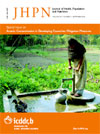
|
The Journal of Health, Population and Nutrition
icddr,b
ISSN: 1606-0997
EISSN: 1606-0997
Vol. 27, No. 4, 2009, pp. 574-586
|
 Bioline Code: hn09055
Bioline Code: hn09055
Full paper language: English
Document type: Research Article
Document available free of charge
|
|
|
The Journal of Health, Population and Nutrition, Vol. 27, No. 4, 2009, pp. 574-586
| en |
Strategies to Reduce Exclusion among Populations Living in Urban Slum Settlements in Bangladesh
Rashid, Sabina Faiz
Abstract
The health and rights of populations living in informal or slum settlements are key development issues of the twenty-first century. As of 2007, the majority of the world’s population lives in urban areas. More than one billion of these people, or one in three city-dwellers, live in inadequate housing with no or a few basic resources. In Bangladesh, urban slum settlements tend to be located in low-lying, flood-prone, poorlydrained areas, having limited formal garbage disposal and minimal access to safe water and sanitation. These areas are severely crowded, with 4-5 people living in houses of just over 100 sq feet. These conditions of high density of population and poor sanitation exacerbate the spread of diseases. People living in these areas experience social, economic and political exclusion, which bars them from society’s basic resources. This paper overviews policies and actions that impact the level of exclusion of people living in urban slum settlements in Bangladesh, with a focus on improving the health and rights of the urban poor. Despite some strategies adopted to ensure better access to water and health, overall, the country does not have a comprehensive policy for urban slum residents, and the situation remains bleak.
Keywords
Informal settlements; Social exclusion; Slums; Slum settlements; Urban health; Bangladesh
|
| |
© Copyright 2009 - International Centre For Diarrhoeal Disease Research, Bangladesh
Alternative site location: http://www.jhpn.net
|
|
